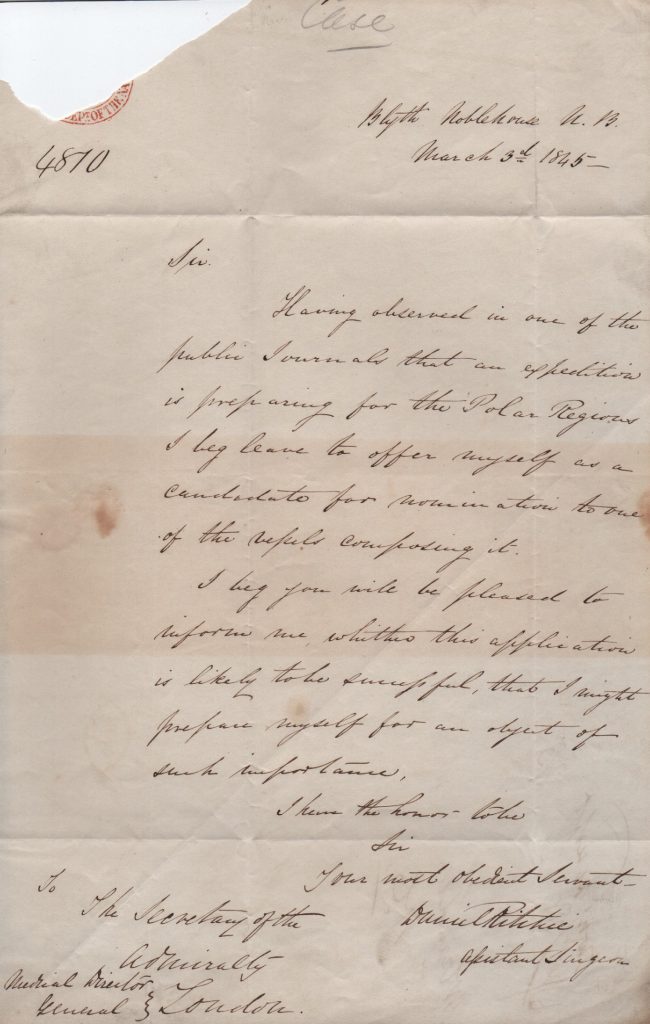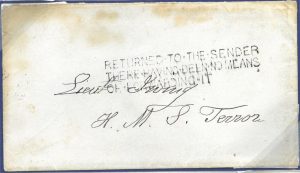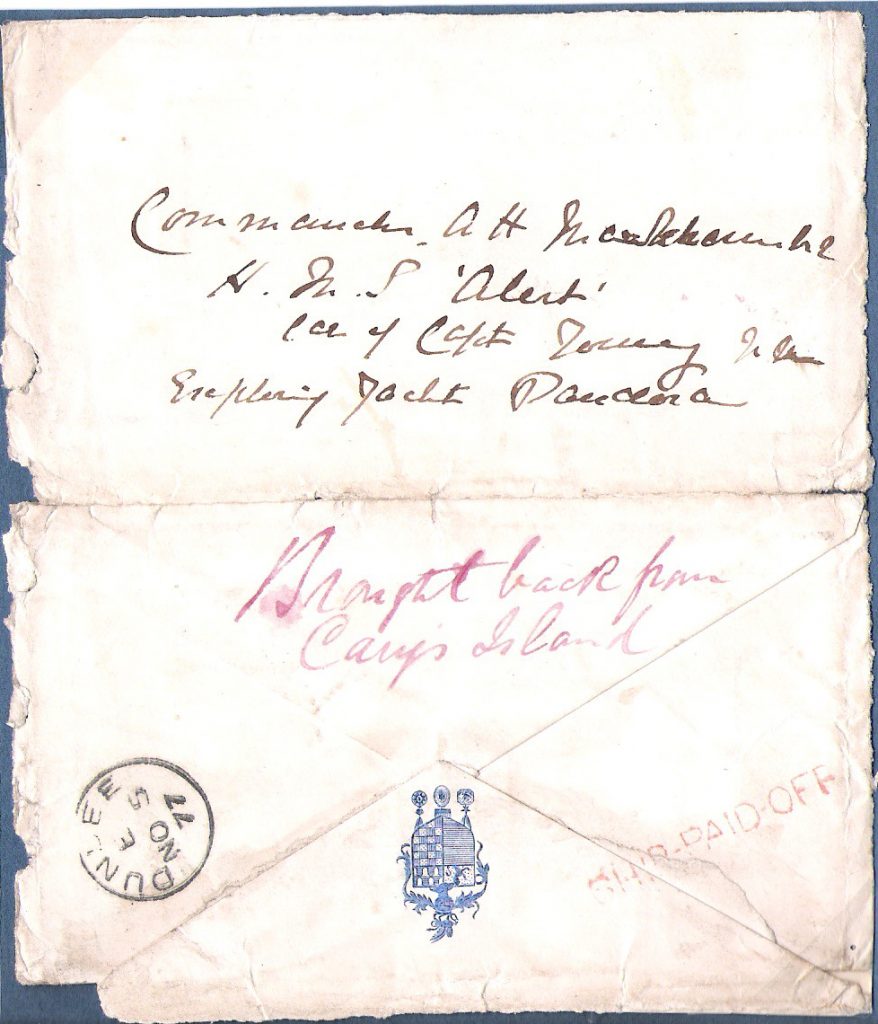History of Arctic Exploration
Some examples from the heroic age of Arctic postal history
Stephen Allen
Exploration to the north of the Arctic Circle was originally driven by national quests for commercial expansion. With the discovery of the American continent being a product of the search for a route to Asia, exploration in the Arctic around the northern edge of North America sought to find a Northwest Passage to the East. In the first half of the 19th century, many British expeditions explored this area.
Wrapper From Captain John Franklin RN.
This wrapper is a request from the leader that two of his members be paid and the money be drawn from his expedition’s account.
An entire wrapper from Captain John Franklin RN to Donald McKenzie Esq, Chief Factor, Hudson Bay Company, Office in Charge of the Company Establishment, Red River Colony. The letter concerns wages due to John Hodgson and Antoine de Chamburt (voyageur) and is dated 25 July 1825 from Fort Chipewyan. It is sealed by Franklin’s personal seal and was written on Navy paper, watermarked Whatman Turkey Mill 1824 and has the Naval coat of arms.


Application to join the Franklin Expedition in 1845


Last Franklin Expedition 1845 – Irving correspondence
This envelope with enclosed letter is from Charles Irving to his cousin, Lt. Irving, R.M.
The mail was taken north on the HMS PLOVER to the Bering Strait in 1848. This small expedition, under Captain Kellet and Captain Moore, had been sent to try to make Contact with Sir John Franklin. Not unnaturally, as Lt. Irving was already dead (probably 1847) this letter was sent back “Return to sender there having been no means of forwarding it”!


Later in the 19th century, other European countries and the United States joined the Arctic exploration nations with grander ideas of promoting their national identity.
In 1858 Adolf Erik Nordenskiöld accompanied his fellow Swede, Otto Torell, to Spitsbergen on the first Swedish Arctic expedition. Nordenskiöld participated in several geological expeditions to Spitsbergen and Greenland before achieving the Northeast Passage on the ship Vega in 1879.

Early in 1860 an American, Charles Francis Hall, met the founder of the American Geographical and Statistical Society and patron of United States Arctic exploration, Henry Grinnell. Grinnell gave him introductions to whaling firms, one of which offered Hall free passage to the Arctic. This was the first of Hall’s arctic expeditions – the last of which he died in suspicious circumstances.

At a meeting of the Royal Geographical Society in London in 1865, a letter from Dr Petermann a German map maker, was read, proposing reaching the North Pole via Spitzbergen, pushing through the ice pack to the North where steamships would reach an open polar sea and sail to the North Pole. Failing to generate interest in a new Arctic expedition in England, Petermann formed his own expedition and raised funds to send the ship Grønland on the First German North Polar Expedition in 1867 and Germania and Hansa on the Second German North Polar Expedition in 1868.

Lieutenant Gustave Lambert was a scientific French naval officer who, hearing of the public attention given to Petermann, proposed in 1866 at the French Geographical Society that France should be rep-resented with an expedition to the North Pole travelling via the Bering Strait. Unhappily for the cause of French polar exploration, the outbreak of the Franco – Prussian war in 1870 put the expedition on hold, and when Lambert himself was killed during the Siege of Paris in January 1871, the expedition was postponed indefinitely.


Since the disappearance of the Franklin expedition of 1845 to discover a Northwest Passage, the British Admiralty became subjected to political and scientific pressure to resume their explorations in a region in which many believed that Britain should be at the forefront.
The British Arctic Expedition of 1875-1876 was sent by the British Admiralty to attempt to reach the North Pole via Smith Sound. Two ships, HMS Alert and HMS Discovery sailed from Portsmouth on 29 May 1875. The coasts of Greenland and Ellesmere Island were extensively explored. Commander Albert Hastings Markham was Captain of HMS Alert, and second-in-command of the British Arctic Expedition under Sir George Nares on the Discovery. During the expedition a sledging party under Commander Markham set a new record Farthest North of 83° 20′ 26″N.
Mail and messages from England for the British Arctic Expedition were taken to Greenland by the ship Pandora under Allen Young and left in the cache on Careys Island as he failed to make contact with the expedition. This cover to Commander Markham was not collected but was picked up by a passing whaling ship and returned to Great Britain and put in the postal service at the first point of call, Dun-dee, in 1877. The cover is written by the wife of Commander Markham. On the reverse of the cover is a straight-line hand struck cachet in red “Ship Paid Off”. And a written endorsement “Brought back from Cary’s Island”

As the 19th century reached its end new countries joined the list of arctic exploration nations. From 1898 to 1902, the second Fram Expedition under Otto Sverdrup carried out an impressive programme of mapping and scientific investigations over the Arctic islands North of Canada.

The Northwest passage was finally achieved by Roald Amundsen on the ship Gjøa in 1906. Amundsen managed this feat by doing almost everything in a manner different from previous European and American expeditions: they used large ships, while he used the tiny Gjøa; they brought preserved food; he hunted for fresh meat and fish; they scorned Inuit methods of travel and living; he spent a year in an Inuit settlement learning their ways.


